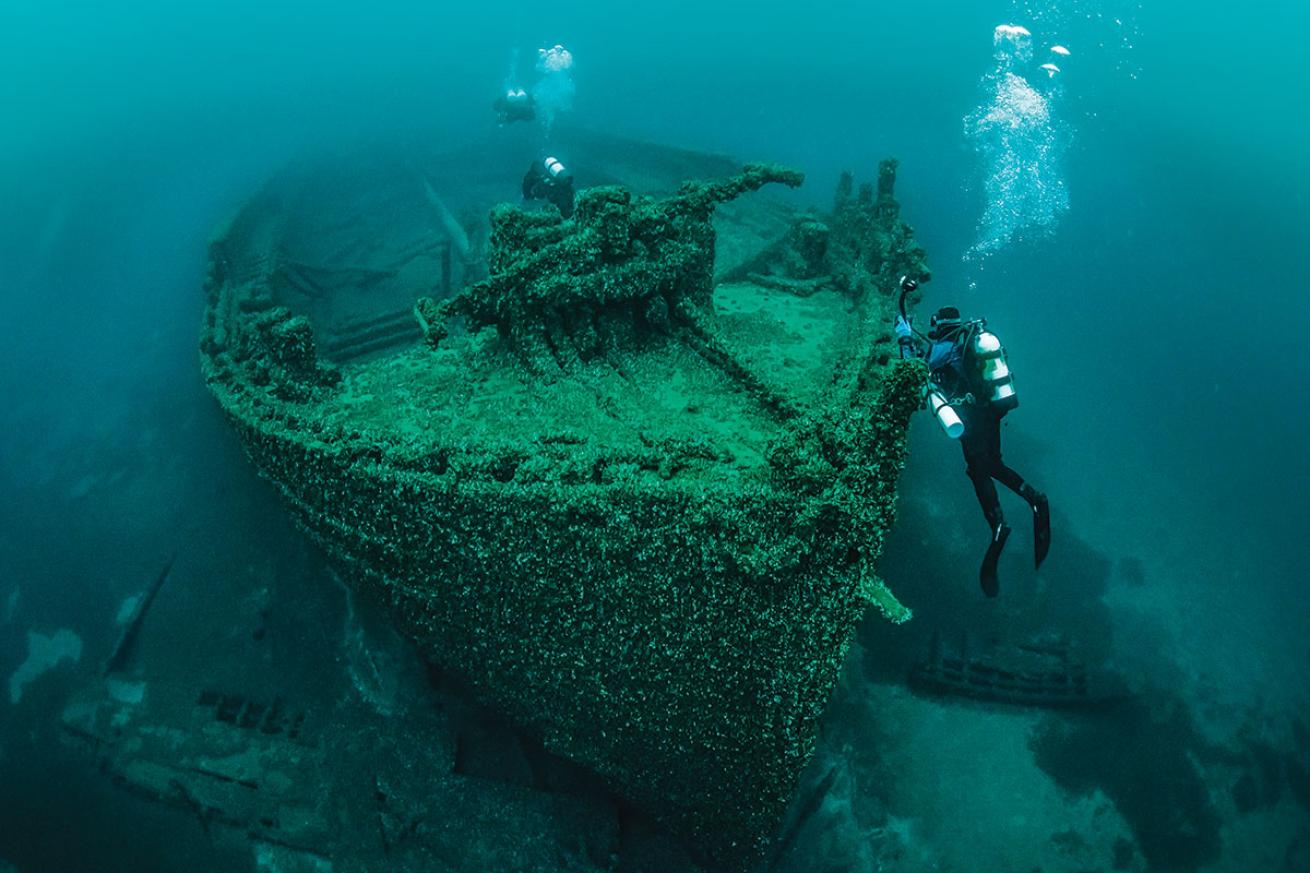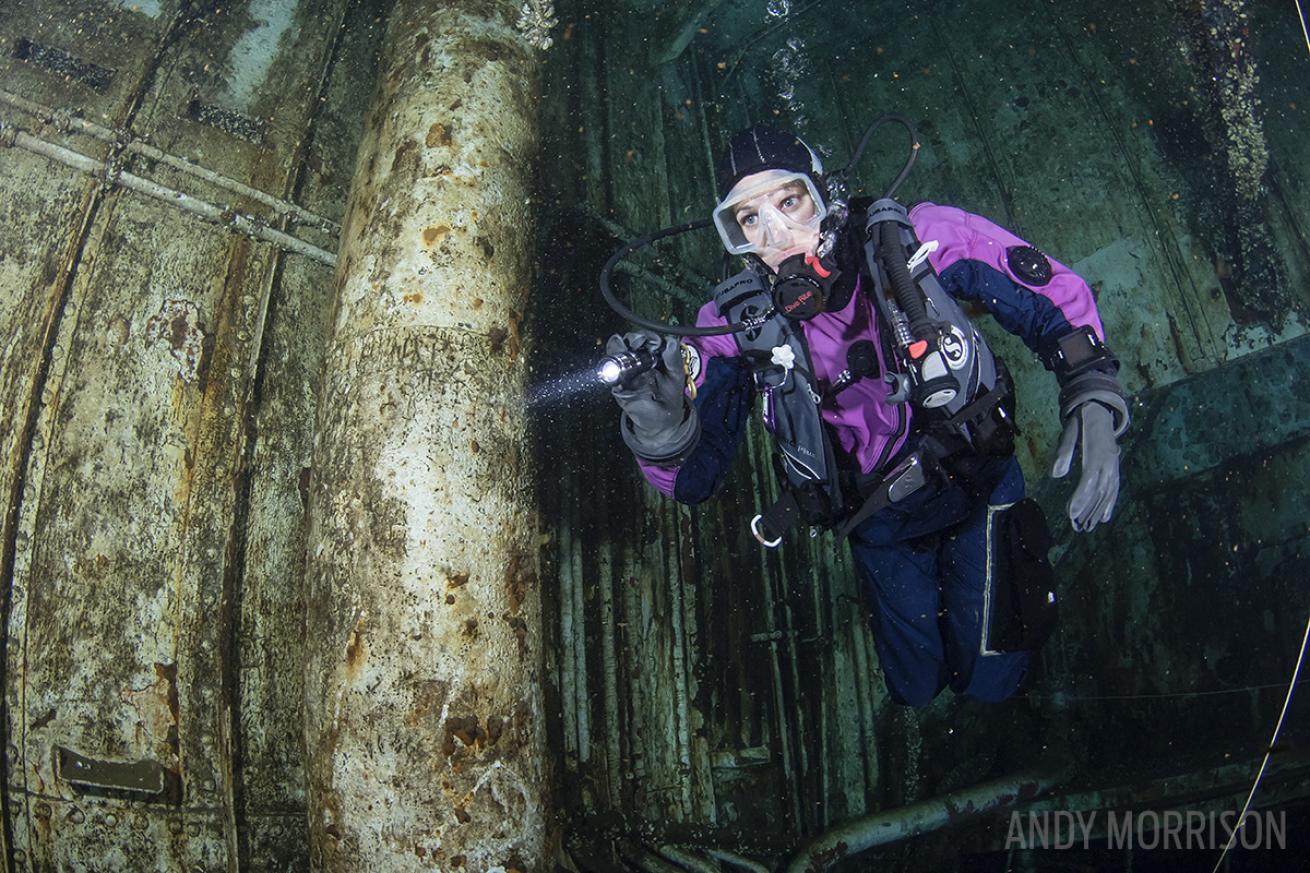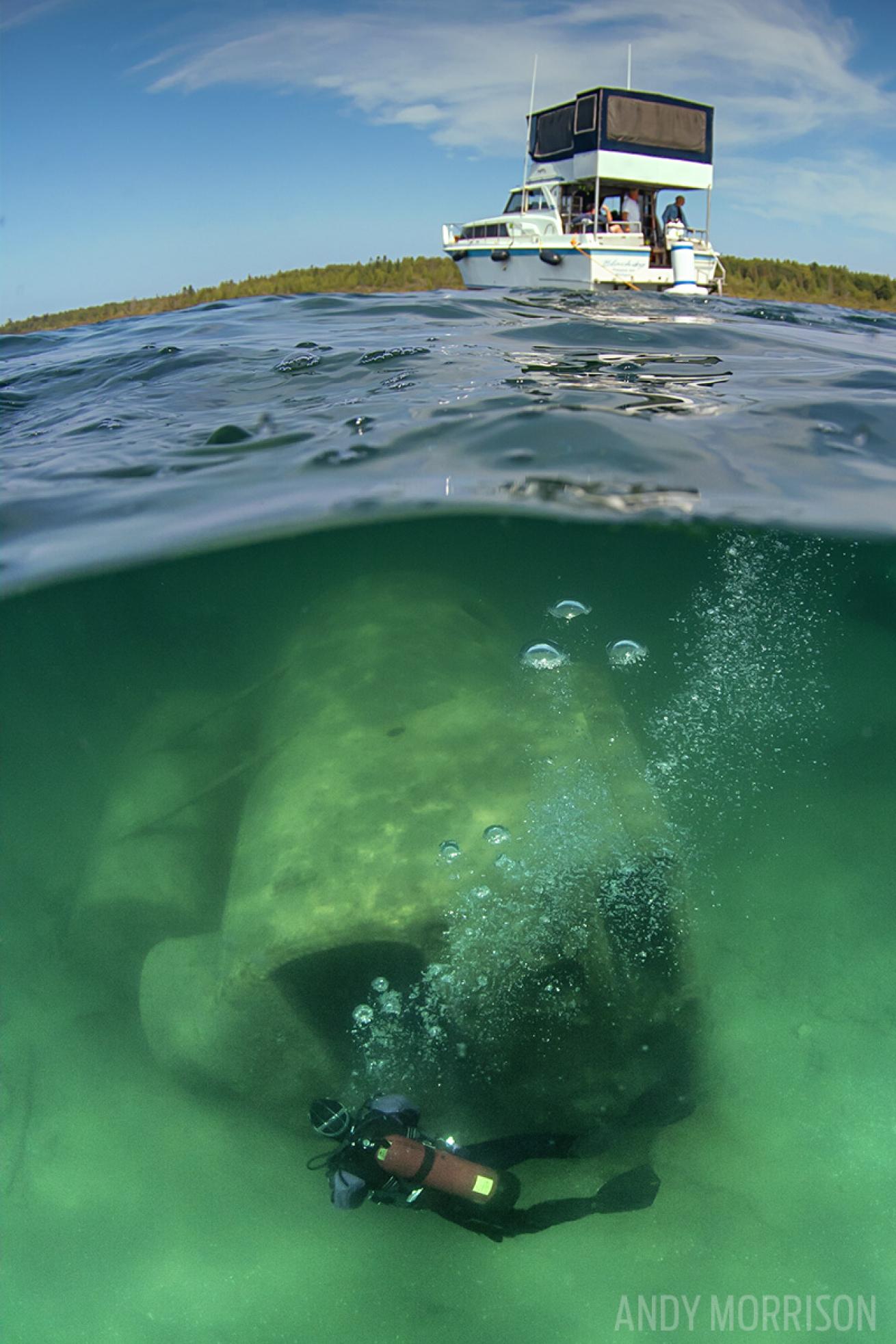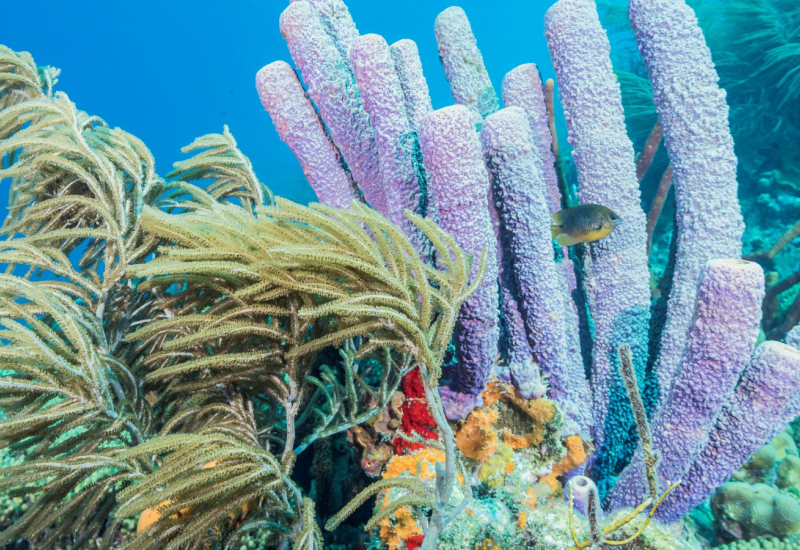Diving Shipwrecks in Michigan's Thunder Bay National Marine Sanctuary
COVID-19 travel restrictions and border closings are constantly evolving. There is no guarantee that the dive sites mentioned within this article will be open at your time of travel.

Andy MorrisonExploring the New Orleans (2) is exclusive to advanced divers. Located 10 miles off the Thunder Bay coast and 150 feet below the surface, this 230-foot bulk freighter joined Shipwreck Alley in 1906 after a collision with a steamer.
Spanning 4,300 square miles from near the tip of Michigan’s “mitten” down to its “second knuckle,” Thunder Bay National Marine Sanctuary & Underwater Preserve is the largest federally funded effort in freshwater shipwreck preservation.
It wasn’t always that big. The first time I visited Thunder Bay, it was 448 square miles of scuba diving adventure. It became one of my favorite Great Lakes dive sites because of the variety and quality of shipwrecks.
Years later, on a recent return visit, I was greeted with diving that was just as I remembered — spectacular. And because there are dozens of shipwrecks within recreational limits, as well as many that fall within technical range, any level of diver will have plenty to see.
Be warned: You’ll likely not have nearly enough time to take in all that Thunder Bay has to offer.
SHIPWRECK ALLEY
Our first day aboard Blackdog Diving Charters was a rainy one. But as we told the patrons in John Boy’s Diner, “We’re going to get wet anyway.”
We made our way out to the Grecian, a steel bulk freighter that sank in 1906 while being towed for major repair. Visibility can reach as far as 80 feet in Thunder Bay, but on this morning, it was significantly less. What was lost in visibility was more than made up for in the 61-degree temperature, downright balmy for a Great Lakes dive.
The first view of the Grecian is of its bow, with its signature anchor davit hanging empty. After some brief exploring, including the intact windlass, we swam over the mostly collapsed body of the 296-foot ship toward the stern and its propeller. Toward the stern, the Grecian regains some of its structure and offers divers an opportunity to drop down into some of its cargo holds.
While penetrating the holds brings you closer to Grecian’s 105-foot resting depth, divers can easily enjoy this wreck hovering above the deck at about 70 feet. At either depth, the Grecian is a must-see wreck in Thunder Bay. Designated in 2000, Thunder Bay National Marine Sanctuary is one of 14 sites managed by the National Oceanic and Atmospheric Administration.
Although at the time we visited it was the only sanctuary in the Great Lakes, Thunder Bay will likely be joined by a second designation in Lake Michigan off the coast of Wisconsin. The new 875-square-mile preserve would run between Port Washington and Two Rivers, Wisconsin.
The areas were chosen because of their variety and sheer number of shipwrecks. In Thunder Bay, they range from ocean-faring freighters to wooden schooners — all ships that met their fate in an area known as Shipwreck Alley.
Of the bevy of wrecks in the preserve, two share a name. The first New Orleans is the oldest known shipwreck in Thunder Bay and lies in just 13 feet of water. The wooden paddle-wheel steamer ran aground in 1849, and local fishermen were able to rescue the passengers and crew. Little remains of the preserve’s matriarch ship, but it’s a dive that can’t be missed.
Conversely, exploring the New Orleans (2) is exclusive to advanced divers. Located 10 miles off the Thunder Bay coast and 150 feet below the surface, this 230-foot bulk freighter joined Shipwreck Alley in 1906 after a collision with a steamer. The steamer survived, but left the New Orleans (2) split in half. Other than this battle wound, the ship is mostly intact.

Andy MorrisonA steel freighter that spent much of its time in the oceans, the Monrovia sank in 1959 after a collision in dense fog while making its first — and last — trip into the fresh waters of the Great Lakes.
A steel freighter that spent much of its time in the oceans, the Monrovia sank in 1959 after a collision in dense fog while making its first — and last — trip into the fresh waters of the Great Lakes. All crew were rescued, but the ship and its cargo of steel dropped about 140 feet to Lake Huron’s bed.
The ride to the Monrovia is lengthy, so we decided to spend two dives at the site. The vessel is 448 feet long, so we knew we had lots to explore.
We descended on the first dive at midship and made our way toward the bow. The temperature on this wreck was about 41 degrees, much chillier than the Grecian but more in line with typical Great Lakes diving — making me thankful I had on a drysuit.
After exploring the cabin and crew quarters, we made our way up the line, a moment we shared with a school of lake trout. Although the Great Lakes are certainly teeming with fish, the site of several hanging around the wreck was something new.
On our second dive, we dropped down to the deck — about 90 feet deep — with a plan to drop into the engine room to see some of the ship’s mechanics. Although a deck hatch allowed us in and several doorways led us out, only experienced divers should penetrate Monrovia.
Sitting upright and mostly intact, it’s is a popular wreck in Thunder Bay and certainly lived up to its reputation.
SHALLOW TREASURES
The next day, we decided to make the trek to the Nordmeer, which rests about 7 miles off Thunder Bay Island in 40 feet of water. I remember my first visit to the 470-foot steel freighter nearly a decade earlier, when portions of it still could be seen above the water’s surface. When the ship was mistakenly run aground in 1966, much of its structure could be seen from land as it lay stranded.
Although once a place for locals to picnic and Boy Scouts to camp, Nordmeer eventually succumbed to nearly five decades of harsh winters and layers of ice, and in 2009, the Nordmeer finally sank below the surface. Although there’s no more view of the ship from land, it is still a playground of mangled shapes covered in a carpet of algae underwater.

Andy MorrisonOnce a wooden steamer measuring nearly 165 feet in length, the Monohansett was all but destroyed in a 1907 fire. What remains — a colossal boiler, its propeller and the bottom portion of its hull, with nails clawing out of the wood — is truly a diving treat between 14-20 feet down.
Another of Thunder Bay’s shallow treasures is one that can be enjoyed just as much by a snorkeler or glass-bottom-boat visitor. Although we were outfitted in our dive gear, we almost didn’t need to be; the Monohansett rests at a depth between 14 and 20 feet.
In fact, by saving a little air on one of our deeper dives, we were able to squeeze in a lengthy dive — the third of the day on the Monohansett.
Once a wooden steamer measuring nearly 165 feet in length, the Monohansett was all but destroyed in a 1907 fire. What remains — a colossal boiler, its propeller and the bottom portion of its hull, with nails clawing out of the wood — is truly a diving treat; most intact wrecks here are too deep to see in natural light.
There is so much to explore in Thunder Bay, on land and under the waves. Whether getting wet or staying topside, both divers and nondivers will come away with a true appreciation of Great Lakes maritime history and this national treasure.
NEED TO KNOW
When To Go: The dive season in the Great Lakes usually begins in late May and lasts through early October.
Dive Conditions: There are nearly 100 known shipwrecks and dive sites in the Thunder Bay National Marine Sanctuary, ranging from novice to technical level. The water is cold — it fluctuates between 35 and 65 degrees — so a drysuit is highly recommended. Visibility can range from 20 feet to 80 feet and beyond.
Operators: Blackdog Diving Charters is run by Capt. Brian Anderson ([email protected]). Air and nitrox fills and dive-gear rentals are available at Thunder Bay Scuba located in Alpena, as well as through Blackdog Diving Charters.
THUNDER BAY ITINERARY
Day 1: Stop in Alpena at John Boy’s Restaurant for a breakfast buffet fit for a seaman. Keep the adventure going after diving by snorkeling a few of the wrecks right offshore, or stay dry and kayak over them.
Day 2: A trip to the Great Lakes Maritime Heritage Center offers 9,000 square feet of exhibits, and an archaeological conservation lab and artifact gallery. Hosting about 60,000 visitors yearly, the center is open year-round except major holidays; hours vary by season. Afterward check out Burgies, where you can order a craft beer and a tasty side of crispy Brussels sprouts with mustard dipping sauce to go with signature burgers like the Taco Salad Burger or the Reuben Burger. (Burgies has plenty of turkey burger options and other alternatives too.)
Day 3: There’s lots to explore on land here as well. In addition to the beaches lining Lake Huron, there are several state parks in the area. Island Park & Wildlife Sanctuary is a serene area within Alpena city limits where you can hike. Or drive a few miles north to Presque Isle, which has two historic and truly picturesque lighthouses. Take the time to seek them both out. You won’t be disapointed.
NOW IN 3D
If you don’t have the chance to dive all of Thunder Bay’s awesome wrecks — and chances are you won’t — take a virtual tour on the Thunder Bay National Marine Sanctuary website. Managed by the National Oceanic and Atmospheric Administration, the site has a plethora of information and includes 3-D tours of some of the preserve’s most popular shipwrecks.
More Places to Drive and Dive!










